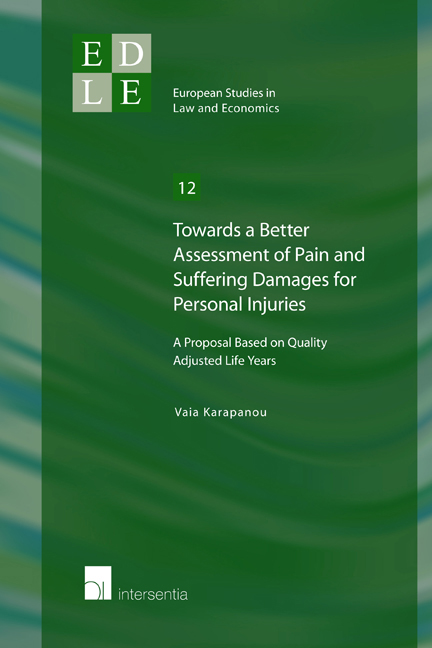 Towards a Better Assessment of Pain and Suffering Damages for Personal Injuries
Towards a Better Assessment of Pain and Suffering Damages for Personal Injuries Book contents
- Frontmatter
- Acknowledgements
- Contents
- Table of Cases
- List of Abbreviations
- List of Tables and Figures
- Chapter 1 Introduction
- Chapter 2 How Should Pain and Suffering Damages be Assessed? A Legal Perspective
- Chapter 3 How Should Pain and Suffering Damages be Assessed? A Law and Economics Perspective
- Chapter 4 Quality Adjusted Life Years. A Measure for the Economic Evaluation of Health Care
- Chapter 5 Using QALYs in a Tort Law Context. Assessing Pain and Suffering Damages
- Chapter 6 Pain and Suffering Damages Based on QALYs. Circumventing Victims' (and Judges') Hedonic Misperceptions
- Chapter 7 The QALY Framework Applied. Practical Examples and Implementation Recommendations
- Chapter 8 Epilogue
- Bibliography
- About the author
- EUROPEAN STUDIES IN LAW AND ECONOMICS
Chapter 6 - Pain and Suffering Damages Based on QALYs. Circumventing Victims' (and Judges') Hedonic Misperceptions
Published online by Cambridge University Press: 22 November 2017
- Frontmatter
- Acknowledgements
- Contents
- Table of Cases
- List of Abbreviations
- List of Tables and Figures
- Chapter 1 Introduction
- Chapter 2 How Should Pain and Suffering Damages be Assessed? A Legal Perspective
- Chapter 3 How Should Pain and Suffering Damages be Assessed? A Law and Economics Perspective
- Chapter 4 Quality Adjusted Life Years. A Measure for the Economic Evaluation of Health Care
- Chapter 5 Using QALYs in a Tort Law Context. Assessing Pain and Suffering Damages
- Chapter 6 Pain and Suffering Damages Based on QALYs. Circumventing Victims' (and Judges') Hedonic Misperceptions
- Chapter 7 The QALY Framework Applied. Practical Examples and Implementation Recommendations
- Chapter 8 Epilogue
- Bibliography
- About the author
- EUROPEAN STUDIES IN LAW AND ECONOMICS
Summary
Calculating pain and suffering damages due to personal injury is a difficult task. To achieve the goals of tort law, as those are stipulated both in legal theory and in law and economics scholarship, the method that should be used to perform this calculation should be able to account for the decrease in health and bodily integrity, as well as the duration of the injury suffered, in a predictable and consistent manner, and at the same time allow the judge to incorporate into her decision particular circumstances pertaining to the case at hand which may influence the amount awarded.
The previous chapter illustrated how a measure that is ‘state of the art’ in the domain of health economics, commonly used to inform the allocation of health care budgets and evaluate the cost-effectiveness of medical interventions, meets the requirements above and is thus well suited to provide a systematic basis for assessing pain and suffering damages. The use of QALYs in the calculation of pain and suffering damages allows the overall reduction in quality of life as a result of the diminution in health and bodily integrity as well as the age of the victim and the duration of injury to figure in the amounts awarded. The range of QALY values in turn allows judges to retain their discretion in choosing the correct value within the range that corresponds to the personal conditions and the specific circumstances of the case.
Besides these qualities, the current chapter suggests that using QALYs in the calculation of pain and suffering damages may have an additional advantage. Under the influence of insights from cognitive psychology, behavioral law and economics have proposed that victims (i.e. plaintiff s) as well as judges may make false predictions about the victims’ future subjective well-being. These false predictions are attributed to the psychological phenomena of hedonic adaptation neglect and the focusing illusion which can influence the calculation of pain and suffering damages and lead to awards that do not correctly reflect the loss of enjoyment of life of the victim due to the injury.
- Type
- Chapter
- Information
- Towards a Better Assessment of Pain and Suffering Damages for Personal InjuriesA Proposal Based on Quality Adjusted Life Years, pp. 147 - 172Publisher: IntersentiaPrint publication year: 2014


